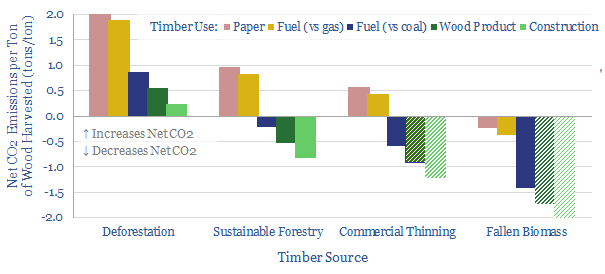The carbon credentials of wood are not black-and-white. They depend on context. So this 13-page note, focusing on wood use CO2 impacts, draws out the numbers and five key conclusions. They highlight climate negatives for deforestation, climate positives for using waste wood and wood materials (with some debate around paper), and very strong climate positives for natural gas.
The CO2 accumulation profile of a forest is set out on pages 2-3. For example, a mature forest absorbs 90% less net CO2 each year than a young forest. This is our baseline for assessing carbon counterfactuals, and numbers can be flexed in our underlying data-file.
Deforestation has net climate negatives across the board. It even emits 35% less CO2 to burn coal (i.e., forests that have been dead for 100M years) than to cut down and burn living forests (page 4).
Conversely, gathering waste wood that has fallen to the forest floor and would otherwise decompose is ‘climate positive’ across every category that we assessed, with other hidden climate benefits (page 5).
Wood materials are the best use of wood, as each ton of sustainably harvested timber avoids 0.5 – 1.2 tons of net CO2 versus using other industrial materials. The note explores how wood product and chemicals companies might benefit from this theme, although paper is an exception and much more debatable (page 6-8).
Wood fuels are still used remarkably widely. But the carbon in lignin and cellulose is already part oxidized, so there is less energy “left to release” as it is converted to CO2. Whereas natural gas derives c54% of its energy release from hydrogen atoms converting to innocuous water vapor. This means each MTpa of LNG can displace an astonishing 10MTpa of CO2 where it prevents the burning of wood from deforestation (pages 9-11).
Biomass power can make sense in some contexts, but only when the wood is sustainably sourced, clearly substitutes coal and helps diversify energy sources/security (page 12).
Our key conclusions and implications for decision-makers are provided on page 13.
